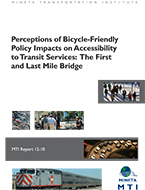- 408-924-7560
- mineta-institute@sjsu.edu
- Donate
Perceptions of Bicycle-Friendly Policy Impacts on Accessibility to Transit Services: The First and Last Mile Bridge
The coordination of bicycle and transit modes has received close attention from public transit planners and researchers in recent years, as transit agencies around the world have installed bicycle racks on transit vehicles, implemented bicycles-on-trains policies, and made other efforts to facilitate bicycle-transit integration. Many planners presume that the catchment area for transit is enlarged by these efforts, but geographic changes in the size of catchment areas have not been effectively documented. This research project was designed to assess the distances travelled on bicycle by cycle-transit users (CTUs), both those who use bicycles as a means of access to transit stops and stations and those who bicycle to and travel on transit with their bicycles. A mixed-methods approach was employed, using a literature review, a survey of cyclist-transit users in Philadelphia and San Francisco, and telephone interviews with a subset of survey respondents. Responses provided by CTUs in the two cities allow us to define their characteristics and behaviors in detail. What is more, they highlight two intriguing conclusions: that transit catchment areas can be much larger for cycle-transit users than for traditional transit users who access transit buses and rail on foot, and that the very concept of a cycle-transit catchment area is quite complex because of the variety of travel opportunities that cycle-transit coordination policies present transit riders. CTUs take advantage of larger catchment areas to reduce their travel costs, and they use those catchment areas in curious, less predictable and more varied ways.
BRADLEY FLAMM, PhD
Bradley Flamm is Assistant Professor in the Department of Community and Regional Planning at Temple University (Ambler, Pennsylvania). He teaches transportation planning, planning methods, and sustainable development courses. His research interests are focused on the environmental and energy impacts of transportation systems and on greenhouse gas (GHG) emissions and climate change action planning at the municipal level. He chairs the Transportation subcommittee of Temple University’s Sustainability Task Force and is co-chair of the Ambler Campus Sustainability Council. He has a BA from the University of California (Berkeley) in Political Science, a Master of Regional Planning from Cornell University, and a PhD in City and Regional Planning from the University of California (Berkeley).
CHARLES RIVASPLATA, PhD
Charles Rivasplata is a lecturer in the Urban and Regional Planning Department at San José State University, where he teaches transport planning classes. He is also a senior transport planner at the San Francisco Municipal Transportation Agency (SFMTA). He earned dual master’s degrees in Civil Engineering and City and Regional Planning from the University of California, Berkeley (1991), and a PhD in Transportation Policy from the University of California, Davis (2006). His doctoral dissertation focused on the impacts of reforms on transit integration in the U.K. His academic research has centered on a number of topics, including transit privatization and deregulation, paratransit operation, regional governance, and travel demand management (TDM).
-
Contact Us
San José State University One Washington Square, San Jose, CA 95192 Phone: 408-924-7560 Email: mineta-institute@sjsu.edu






